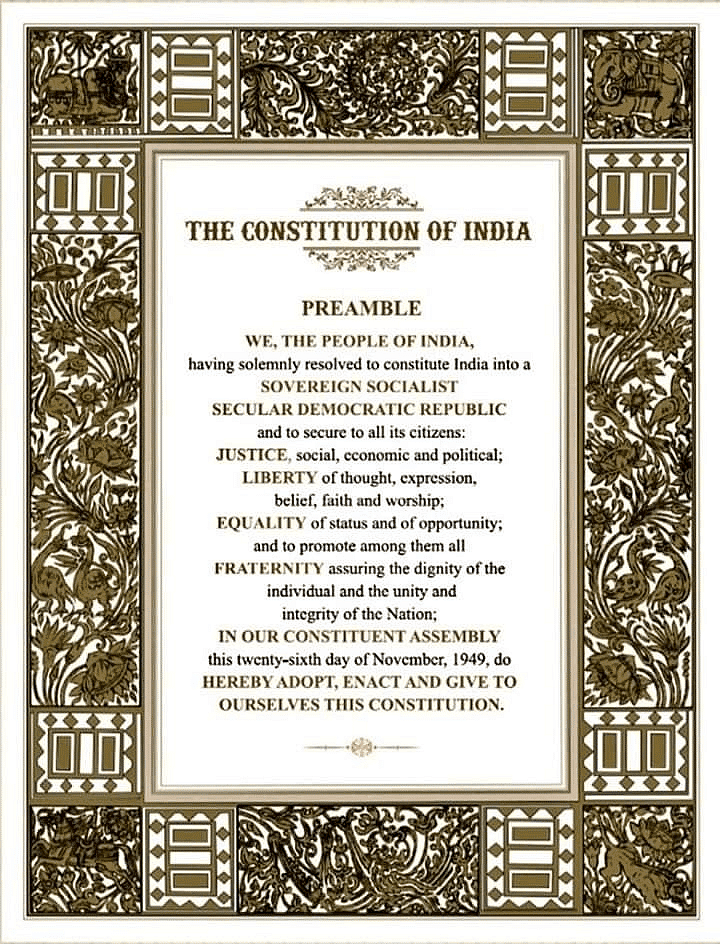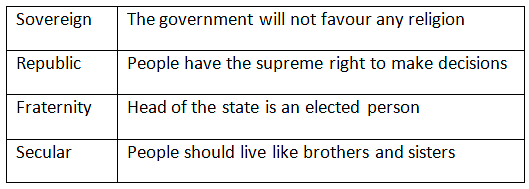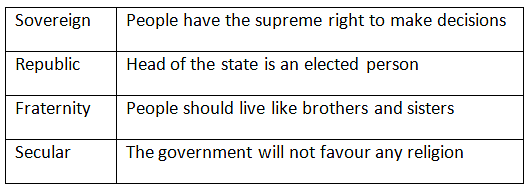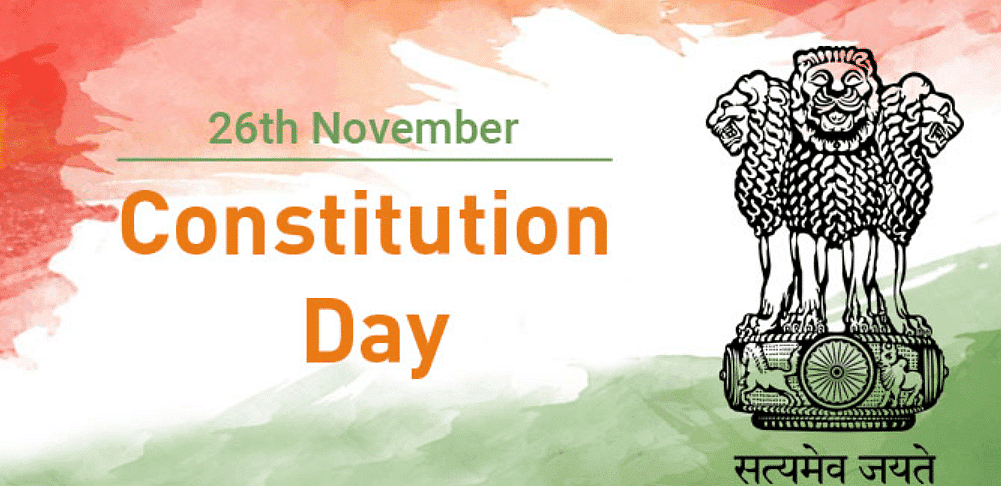NCERT Solutions for Class 9 Civics Chapter 2 - Constitutional Design
Q1. Here are some false statements. Identify the mistake in each case and rewrite these correctly based on what you have read in this chapter.
(a) Leaders of the freedom movement had an open mind about whether the country should be democratic or not after independence.
(b) Members of the Constituent Assembly of India held the same views on all provisions of the Constitution.
(c) A country that has a constitution must be a democracy.
(d) Constitution cannot be amended because it is the supreme law of a country.
Ans:
(a) Leaders of the freedom movement agreed that the country should be a democratic nation after independence.
(b) Members of the Constituent Assembly worked in a systematic, open, and consensual manner to resolve differences among them.
(c) It is not necessary for a country to have a constitution to be a democracy. The constitution of a country can even make provisions for dictatorship or monarchy.
(d) A constitution can be amended to keep up with the changes in aspirations of the society.

Q2. Which of these was the most salient underlying conflict in the making of a democratic constitution in South Africa?
(a) Between South Africa and its neighbours
(b) Between men and women
(c) Between the white majority and the black minority
(d) Between the coloured minority and the black majority
Ans: (c) Between the white majority and the black minority
The most salient underlying conflict in the making of a democratic constitution in South Africa was between the white minority and the black majority.
Q3. Which of these is a provision that a democratic constitution does not have?
(a) Powers of the head of the state
(b) Name of the head of the state
(c) Powers of the legislature
(d) Name of the country
Ans: (b) Name of the head of the state
The democratic constitution does not have the name of the head of the state, as the head of the state is elected by the citizen of the country. The head of the state changes after after a specific term; hence, there is a provision that a democratic constitution does not have the name of the head of the state.
Q4. Match the following leaders with their roles in the making of the Constitution
Ans:
Q5. Read again the extracts from Nehru's speech “Tryst with Destiny” and answer the following:
(a) Why did Nehru use the expression “not wholly or in full measure” in the first sentence?
(b) What pledge did he want the makers of the Indian Constitution to take?
(c) “The ambition of the greatest man of our generation has been to wipe every tear from every eye”. Who was he referring to?
Ans:
(a) Nehru used the phrase "not wholly or in full measure" because he believed the work they had started was not yet finished. He knew it wasn't possible to fulfil their promises all at once, but that they would be achieved gradually over time.
(b) The pledge Nehru wanted the makers of the Indian Constitution to take was to commit their lives to serving India, its people, and humanity as a whole.
(c) He was referring to Mahatma Gandhi, the father of our nation.

Q6. Here are some of the guiding values of the Constitution and its meaning. Rewrite them by matching them correctly.
Ans:
Q7. How did your school celebrate Constitution Day on November 26th? Prepare a brief report.
Ans: Students should write their report on their own if they have celebrated Constitution Day on November 26th.

Q8. Here are different opinions about what made India a democracy. How much importance would you give to each of these factors?
(a) Democracy in India is a gift of the British rulers. We received training to work with representative legislative institutions under the British rule.
(b) Freedom Struggle challenged the colonial exploitation and denial of different freedoms to Indians. Free India could not be anything but democratic.
(c) We were lucky to have leaders who had democratic convictions. The denial of democracy in several other newly independent countries shows the important role of these leaders.
Ans:
(a) Democracy was chosen as the prime value of our nation during the freedom struggle against the British. Yes, with the Indian Councils Act, Indians started participating in the councils, and hence, their experiences paved the way for legislative institutions in independent India.
(b) The freedom struggle did challenge colonial exploitation, but it worked for democracy by making laws with consensus and not imposing anything on anyone.
(c) Our freedom struggle fought a bloodless struggle with tools like ‘Satyagraha’ and ‘Ahimsa.’ These struggles were undertaken to free India from the clutches of the British and give Indians the freedom they deserved.
Q9. Read the following extract from a conduct book for ‘married women’, published in 1912. ‘God has made the female species delicate and fragile both physically and emotionally, pitiably incapable of self-defence. They are destined thus by God to remain in male protection – of father, husband and son – all their lives. Women should, therefore, not despair, but feel obliged that they can dedicate themselves to the service of men’. Do you think the values expressed in this para reflected the values underlying our constitution? Or does this go against the constitutional values?
Ans: The values expressed in the above-mentioned paragraph do not reflect the values underlying our Constitution. Our constitution gives fundamental rights to each of its citizens regardless of gender, caste, sex, place of birth, and religion. Women are given equal rights to men in our constitution, i.e., equality is ensured through Fundamental Rights as well as protected under various articles such as Article 14 (equality before the law) and Article 15 (prohibition of discrimination).
Q10. Read the following statements about a constitution. Give reasons why each of these is true or not true.
(a) The authority of the rules of the constitution is the same as that of any other law.
(b) Constitution lays down how different organs of the government will be formed.
(c) Rights of citizens and limits on the power of the government are laid down in the constitution.
(d) A constitution is about institutions, not about values.
Ans:
(a) Not True
The constitution is the supreme law of the land, meaning it holds higher authority than ordinary laws. All other laws must comply with the constitution. If a law contradicts the constitution, it can be declared unconstitutional and invalid by the courts. The constitution provides the framework for governance, outlines the rights of citizens, and sets limits on the powers of the government, making it superior to regular laws.
(b) True
The constitution lays down the framework for government formation. It defines in detail the composition and functions of the different organs of government, namely the executive, the judiciary and the legislature.
(c) True
The constitution lays down the fundamental rights of every citizen of the country. These rights are enforceable in a court of law. By defining the structure and functions of the different organs of government and by making them independent in their own spheres, yet keeping each organ under check by the other organs, the constitution ensures that there are proper limits to the powers exercised by the government.
(d) Not True
A constitution lays down the composition and functions of the different institutions of government, thereby providing the framework and laws for the working of these institutions. However, providing such laws and frameworks, it is strongly guided by democratic principles and values. Hence, a constitution is as much about values as it is about the institutions based on these values.
|
55 videos|437 docs|80 tests
|
FAQs on NCERT Solutions for Class 9 Civics Chapter 2 - Constitutional Design
| 1. What is the importance of constitutional design in a democracy? |  |
| 2. How does the Indian Constitution reflect the principles of democracy? |  |
| 3. What are the key features of the Indian Constitution that promote social justice? |  |
| 4. How did the framers of the Indian Constitution address the diversity of India? |  |
| 5. What role does the Constitution play in protecting the rights of citizens? |  |



















